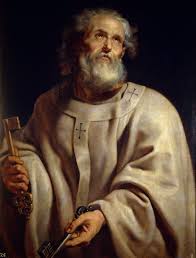Saint Peter

From Wikipedia, the free encyclopedia Jump to navigationJump to search For other uses, see Saint Peter (disambiguation).
| Saint Peter | |
|---|---|
| Apostle, pope, patriarch, and martyr | |
| Saint Peter (c. 1468) by Marco Zoppo depicts Peter as an old man holding the Keys of Heaven and a book representing the gospel. | |
| Church | Early Christian Great Church |
| See | First Bishop of Rome (pope), according to Catholic tradition First Bishop of Antioch (patriarch), according to Eastern Christian tradition |
| Installed | AD 30[1] |
| Term ended | between AD 64 and 68[2] |
| Successor | Bishop of Rome: Linus Bishop of Antioch: Evodius |
| Orders | |
| Ordination | AD 33 by Jesus Christ |
| Personal details | |
| Birth name | Shimon (Simeon, Simon) |
| Born | c. AD 1 Bethsaida, Gaulanitis, Syria, Roman Empire |
| Died | between AD 64 and 68 (aged 62–67) Clementine Chapel, Vatican Hill, Rome, Italia, Roman Empire |
| Parents | John (or Jonah; Jona) |
| Occupation | Fisherman, clergyman |
| Sainthood | |
| Feast day |
Main feast (with Paul the Apostle) 29 June (Catholic Church, Eastern Orthodox Church, Oriental Orthodoxy, Anglicanism, Lutheranism) Chair of Saint Peter in Rome 18 January (pre-General Roman Calendar of 1960) Confession of Saint Peter 18 January (Anglicanism) Chair of Saint Peter 22 February (Catholic Church) Saint Peter in Chains 1 August (pre-1960 Roman Calendar) |
| Venerated in | All Christian denominations that venerate saints, Islam |
| Canonized | Pre-Congregation |
| Attributes | Keys of Heaven, Red Martyr, pallium, papal vestments, rooster, man crucified upside down, vested as an Apostle, holding a book or scroll, Cross of Saint Peter. Iconographically, he is depicted with a bushy white beard and white hair. |
| Patronage | Patronage list |
| Shrines | St. Peter’s Basilica |

Saint Peter (Syriac/Aramaic: ܫܸܡܥܘܿܢ ܟܹ݁ܐܦ݂ܵܐ, Shemayon Keppa; Hebrew: שמעון בר יונה Shim’on bar Yona; Greek: Πέτρος, translit. Petros; Coptic: ⲡⲉⲧⲣⲟⲥ, translit. Petros; Latin: Petrus; r. AD 30;[1] died between AD 64 and 68),[2] also known as Simon Peter, Simeon, or Simon (/ˈsaɪmən/, pronunciation (help·info)), according to the New Testament, was one of the Twelve Apostles of Jesus Christ, leaders of the early Christian Great Church. Pope Gregory I called him repeatedly the “Prince of the Apostles“.[3] According to Catholic teaching, Jesus promised Peter in the “Rock of My Church” dialogue in Matthew 16:18 a special position in the Church. He is traditionally counted as the first Bishop of Rome—or pope—and also by Eastern Christian tradition as the first Patriarch of Antioch. The ancient Christian churches all venerate Peter as a major saint and as the founder of the Church of Antioch and the Roman Church,[2] but differ in their attitudes regarding the authority of his present-day successors (the primacy of the Bishop of Rome).
The New Testament indicates that Peter’s father’s name was John (or Jonah or Jona)[4] and was from the village of Bethsaida in the province of Galilee or Gaulanitis. His brother Andrew was also an apostle. According to New Testament accounts, Peter was one of twelve apostles chosen by Jesus from his first disciples. Originally a fisherman, he played a leadership role and was with Jesus during events witnessed by only a few apostles, such as the Transfiguration. According to the gospels, Peter confessed Jesus as the Messiah,[5] was part of Jesus’s inner circle,[6] thrice denied Jesus[7] and wept bitterly once he realised his deed, and preached on the day of Pentecost.[8]
According to Christian tradition, Peter was crucified in Rome under Emperor Nero. It is traditionally held that he was crucified upside down at his own request, since he saw himself unworthy to be crucified in the same way as Jesus. Tradition holds that he was crucified at the site of the Clementine Chapel. His remains are said to be those contained in the underground Confessio of St. Peter’s Basilica, where Pope Paul VI announced in 1968 the excavated discovery of a first-century Roman cemetery. Every 29 June since 1736, a statue of Saint Peter in St. Peter’s Basilica is adorned with papal tiara, ring of the fisherman, and papal vestments, as part of the celebration of the Feast of Saints Peter and Paul. According to Catholic doctrine, the direct papal successor to Saint Peter is the incumbent pope, currently Pope Francis.
Two general epistles in the New Testament are ascribed to Peter, but modern scholars generally reject the Petrine authorship of both.[9] The Gospel of Mark was traditionally thought to show the influence of Peter’s preaching and eyewitness memories. Several other books bearing his name—the Acts of Peter, Gospel of Peter, Preaching of Peter, Apocalypse of Peter, and Judgment of Peter—are considered by Christian denominations as apocryphal, and are thus not included in their Bible canons.[10][11][12]
